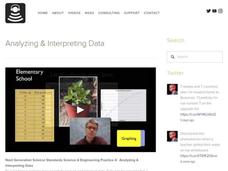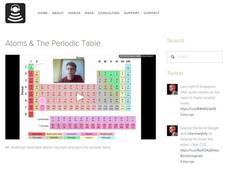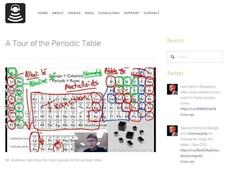Bozeman Science
NGSS: Patterns
The Next Generation Science Standards list the first concept for all disciplines as patterns. Learners view the progression as scholars move from grade to grade and apply these skills in an informative video on the NGSS
Bozeman Science
NGSS: Constructing Explanations and Designed Solutions
The Next Generation Science Standards list constructing explanations and designing solutions as the sixth practice. The video explains how scientists create and modify theories over time. Then, it offers many examples of scientific...
Bozeman Science
NGSS: Analyzing and Interpreting Data
The third practice in the Next Generation Science Standards applies analyzing and interpreting data. The video explains why this is important to scientists and many different ways to organize data. Then it moves on to discuss how to...
Bozeman Science
NGSS: Developing and Using Models
The Next Generation Science Standards list Developing and Using Models as the second science and engineering practice. The video explains conceptual models and the expectations for K-12th grade scholars. It highlights the progression of...
Bozeman Science
Sound Waves
How does that sound look? Teach the characteristics of sound waves through a video lesson that shows an analysis of different frequencies and amplitude of sound waves. The instructor also represents the characteristics of the sound...
Bozeman Science
Light
Colors, a variation of the wavelength of light they emit, is the focus of a video that explains the different frequencies of light waves, models how our brain processes the electromagnetic radiation, and how we perceive light.
Bozeman Science
Waves
Calculating frequency is so easy it Hertz! The video begins by describing transverse and longitudinal waves, and then it explores their properties and applications. Finally, it applies this to the formulaic relationships between wave...
Bozeman Science
Acids, Bases and pH
This resource must have a greater concentration of hydroxide ions than hydrogen ions because it makes pH seem basic. The video describes what happens on a molecular level to change the pH of a liquid and focuses on the importance of...
Bozeman Science
Limiting Reactants and Percent Yield
Viewers watch while the narrator explains limiting reactions through the familiar example of a recipe. He then describes why it is necessary to use moles to solve these problems rather than just relying on diagrams. The video ends...
Bozeman Science
Naming Compounds - Part 2
CH2O is not the formula for seawater, and this resource explains why. The video models how to write the chemical formula when given the chemical name in both covalent an ionic forms.
Bozeman Science
Beginner's Guide - Balancing Equations
Using impactful visuals and chemical equations, this video describes how to balance chemical equations. It uses examples that are common to the classroom such as methane burning in a Bunsen burner.
Bozeman Science
Atoms and the Periodic Table
After discovering plutonium, Glenn Seaborg was given the opportunity to determine its periodic symbol. Rather than going with the obvious Pl, he went with Pu as a joke. The designation was approved and is now on every periodic...
Bozeman Science
Chemical Bonds - Covalent vs Ionic
A chemistry walks viewers through non-polar covalent, polar covalent, and ionic bonds and how to determine the type of specific chemical bonds.
Bozeman Science
A Tour of the Periodic Table
The major groups on the periodic table and their general properties based on their electrons are the focus of a video that also explains why the table is drawn in two parts and which elements are crucial to life.
Bozeman Science
Matter
In 1924, Bose and Einstein predicted a fifth state of matter. The prediction proved to be true in 1995 and is referred to as the Bose-Einstein condensation. This video discusses the concept of matter, all five states of matter, and what...
Bozeman Science
History of the Atom
Viewers learn about the history of our knowledge of atoms through the discoveries of eight different scientists: Mendeleev, Democritus, Dalton, Thompson, Schrodinger, Bohr, Rutherford, and Chadwick.
Bozeman Science
Position vs Time Graph - Part 1
Learners investigate the relationship of position with respect to time in a graphical situation and develop an understanding of the slope related to the object in motion. They then use that understanding to create a velocity versus time...
Bozeman Science
Eukarya
Although very diverse, Domain Eukarya is the only domain where the organisms are made of eukaryotic cells. The narrator explores the Domain Eukarya. He discusses the characteristics of eukaryotic cells and shows how these evolved over...
Bozeman Science
Animals
For every human in the world, there are one million ants! The instructor shows the phylogenetic tree of animals and where they stand compared to other organisms. The video then focuses on vertebrates and invertebrates, exploring what...
Bozeman Science
Scalars and Vectors
Investigate the purpose of vectors as they relate to physics concepts. The instructor explains quantities that have magnitude and those that have both magnitude and direction. He explains the scalar and vector quantities in relation to...
Bozeman Science
Blood Types
Young scientists learn the importance of knowing blood types and their compatibility. The instructor in the video explains each type of blood and their antigens and antibodies, and then differentiates between AB blood and Rh blood...
Bozeman Science
Radiation and Radioactive Decay
Why does radiation occur? Learn the reason and the main types of radiation during this video lesson. Scholars discover the makeup of a radioactive atom and the effect of the different types of radiation. They then analyze and create...
Bozeman Science
Nuclear Reactions
How does a nuclear reaction create such a large amount of energy? The idea of a nuclear reaction develops from a comparison with chemical reactions. The video instructor then explains the process of both nuclear fission and fusion. This...
Bozeman Science
Series and Parallel Circuits
Build an understanding of electrical circuits in series and parallel. The video instructor demonstrates the effects of manipulating both a series and parallel circuit. Learners realize the difference between the types of circuits as well...























